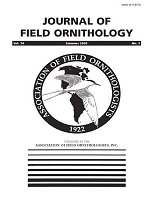Ecological studies and population surveys sometimes require information on the position of individuals. Because many birds are more audible than visible, we tested the potential of acoustic triangulation for locating Great Bitterns (Botaurus stellaris) within extensive reed marshes in the Camargue, France. During the breeding season, and predominantly at dawn, male bitterns produce a series of loud calls (booms). In the field, the direction of booming was estimated with a bearing compass by an observer walking along a linear path at the reedbed edge, taking enough measurements to cover a 90° wide angle between the first and last bearing. We used a probability model with an Andrews estimator to locate each bittern based on the intersection point of the bearings taken in the field. Bearing error was estimated by comparing these bearings with those derived from the real or estimated bird position. In a first experiment, we identified the factors influencing the variation in bearing error using six observers, 237 directional bearings, and 19 bitterns. In a second experiment, we quantified the bearing accuracy under optimal conditions based on three observers using 47 directional bearings to locate a bittern of known position. There was no observer effect, but wind speed above 10 km/h, occurrence of poor booms, and bittern distance under 200 m significantly increased bearing error. Bitterns calling normally under windless conditions could be located with a mean bearing accuracy of ±13.6°. Location accuracy depended primarily on the bird distance and number of bearing angles. We propose an optimal bearing effort to locate booming males in large reedbeds with an accuracy of a 40-m radius irrespective of the bittern distance. This protocol can be applied to other bird species once the bearing accuracy corresponding to their call and habitat has been estimated. Acoustic triangulation appears to be a useful, non-invasive, technique for locating bitterns and other bird species.
How to translate text using browser tools
1 July 2003
Accuracy of bittern location by acoustic triangulation
Gaëtan Lefebvre,
Brigitte Poulin
ACCESS THE FULL ARTICLE
It is not available for individual sale.
This article is only available to subscribers.
It is not available for individual sale.
It is not available for individual sale.

Journal of Field Ornithology
Vol. 74 • No. 3
July 2003
Vol. 74 • No. 3
July 2003
acoustic triangulation
booming site
Botaurus stellaris
France
localization accuracy
reedbed
vocalization




